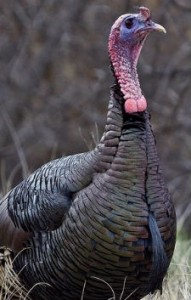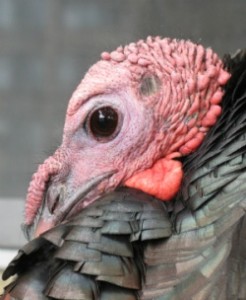Can You Tell A Snood From A Wattle? Let’s Talk Turkey About Our Favorite Bird
by eNature
It’s after Thanksgiving and many of us are thinking about our annual feast and the turkey that’s often at the center of it.
But how much do you know about the creature that many folks think is our REAL national bird?
Turkeys are interesting birds— they’re large, colorful and hard to miss when they’re in a demonstrative mood. Many researchers have devoted their entire career to studying them and their complex social structure.
A Bird For All Americans
As recently as a generation ago, folks rarely encountered Wild Turkeys. Hunting pressure had eliminated them from much of their original range. But extensive reintroduction efforts brought the turkey back from the brink and just about every state in the continental US now has populations of wild turkeys, some in the tens of thousands. You can see from the range map to right how widely distributed turkey’s now are.
Snoods, Wattles and Beards
So what exactly is a turkey’s snood? Male, or tom, turkeys have a number of features that experts believe are intended to attract female turkeys (hens). These include the familiar fleshy red wattles on its neck and throat as well as a fleshy mass over their beak known as a snood. As turkeys are polygamous and happy to mate with as many hens as they can attract, it seems reasonable to conclude that a more spectacular wattle and snood will result in more breeding success.
A tom’s plumage follows the same principles. Bright colors and unique features rule the day. His feathers have areas of green, copper, bronze, red, purple, and gold iridescence. Most males also have a beard; in reality a group of specialized feathers growing from the center of his breast. The photo to the above right clearly shows many of the tom’s irresistible (to hens at least) qualities.
Strutting Their Stuff
Males attract hens by a behavior known as “strutting”, in which they display for females by puffing out their feathers, spreading out their tails and dragging their wings. Gobbling, drumming or booming and spitting as signs of social dominance are also techniques toms use to attract females.
Sounds a bit like highschoolers at a Friday night football game!
Overcoming Adversity
Wildlife managers estimate that the entire population of Wild Turkeys in the United States was as low as 30,000 in the early 20th century. By the 1930s,they were almost totally extirpated from Canada and found only in remote pockets within the US. Populations have rebounded spectacularly since programs across the country were put in place to protect and encourage the breeding of surviving wild populations. The rebound has reached the point where hunting has been legalized in the lower 48 states and current estimates place the entire Wild Turkey population at over 7 million.
Wild Turkey or Bald Eagle?
It’s not your bartender taking your order, but rather an interesting bit of American history. In the early days of the republic, Benjamin Franklin strongly objected to the choice of the Bald Eagle as our national symbol, preferring the Wild Turkey.
Franklin thought the Bald Eagle’s habit of stealing prey caught by other birds, particularly ospreys, an inappropriate quality and wrote, “For the Truth the Turkey is in Comparison a much more respectable Bird, and withal a true original Native of America”.
We tend to agree with Ben— the turkey, a uniquely North American bird, is an American original and worthy of our respect.




